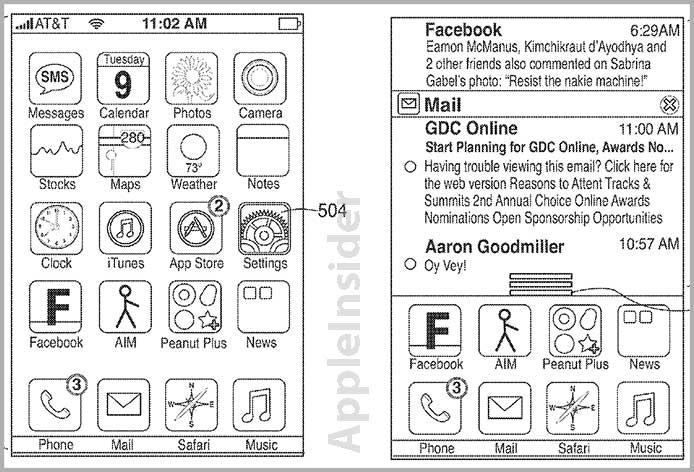A filing published by the U.S. Patent and Trademark Office on Thursday reveals that Apple is looking to patent the iOS Notification Center, a feature similar to Google's Notification Bar which allows mobile device users to keep tabs on a multitude of apps from a central hub.
Apple's application, titled "Systems and methods for displaying notification received from multiple applications," offers an outline of a system that can receive and aggregate "notifications" or alerts from a number of apps within iOS.
As with many other operations level iOS features, Notification Center is the result of an ongoing effort to create a more inviting and intuitive experience for the end user. In this case, however, many believe that Apple cribbed the functionality from Google's Android OS which implemented a very similar notification system before Notification Center was introduced in iOS 5. The internet search giant actually filed its own patent application for what it calls "Notification Bar" in 2009, some two years prior to Apple's "Notification Center" filing.
Most recently, Samsung sued Apple in South Korea, alleging the iOS Notification Center infringes on active patents. Not much information has been made available in the reported suit, though the "active patent" is believed to be related to Google's Notification Bar.
Illustration from Google's Notification Bar patent application.Before iOS 5, Apple's mobile operating system had no "central hub" to which apps could send messages and notifications. Examples would be push notifications from messaging apps, new emails and alerts from reminder apps, all of which would have to be found by the user through a manual search of the graphical user interface.
From the application's background:
Because electronic devices can contain many applications, the potential for application-based notifications can become numerous and unwieldy, particularly if a user is required to access each application individually in order to view application-specific notifications. Accordingly, what is needed is a more efficient and intuitive approach for organizing notifications and providing users with instant access to these notifications.
In Apple's solution, a central "notification module" can interface with a plurality of Application Programming Interfaces (APIs) while the device is either locked or unlocked and present the messages or alerts to the user according to a customizable display scheme. As seen in the current iteration of Notification Center, users can select which apps are granted access, the amount of notifications that are displayed and how they are presented on screen.
For example, notifications from an instant messaging app can be displayed in a pop-up window that requires user intervention to dismiss, or banner that temporarily takes over the top of the screen and disappears within a few seconds. The system can be further refined to present a set number of messages as well as where those messages appear in the Notification Center's hierarchy.
Illustration of banner notifications.The Notification Center window is a scrollable list that sections alerts from multiple apps into panes, a number of which can be made into permanent "widgets" that display data from Apple's weather and stock apps. Users can access the centralized hub at anytime, even if the device is running another app.
Example of static weather widget (608) and stock stock widget (610).Other notable assets are badge app icons relating to the number of notifications sent by a given app, the ability to interact with alerts while the phone is locked and context-sensitive slider functions which bring a user directly to a notifying app from the lock screen.
"Slide to Unlock" alternatives as seen in lock screen.Apple's patent application was first filed in June 2012 and claims the benefit of a provisional application from June 2011, both of which credit Imran A. Chaudhri and Eliza Block as its inventors. The patent application was cross-filed with the World Intellectual Property Organization in 2012.
 Mikey Campbell
Mikey Campbell







-m.jpg)






 Charles Martin
Charles Martin

 Malcolm Owen
Malcolm Owen
 William Gallagher
William Gallagher

 Christine McKee
Christine McKee
 Wesley Hilliard
Wesley Hilliard









62 Comments
It's all about implementation.
It's all about implementation.
So you're arguing Android doesn't infringe on anything Apple, due to being a different implementation? Good :D
To all the people who claim Apple cribbed Android's Notification Bar: WebOS had it first, and Apple hired WebOS's notification engineer. Moreover, you can't get in trouble for taking somebody's work if that work was a derivative of your own copyrighted work. Go ask the guy who wrote an unsolicited screenplay for Rocky 4 and sent it to Stallone in an attempt to get hired. Stallone just took it, made the movie, and didn't pay the guy. The guy sued and the Court ruled that because the guy's work was a derivative of Stallone's work(e.g. Based on character's Stallone created), the guy had no case.
So you're arguing Android doesn't infringe on anything Apple, due to being a different implementation? Good :D
It's not so simple. Patents are very specific. You have to read the claims to know what the patent protects.
Let's be real. If it was the other way around and iOS had the notification center years before Android did, people here would be talking sh-- left and right about Android stealing that idea.